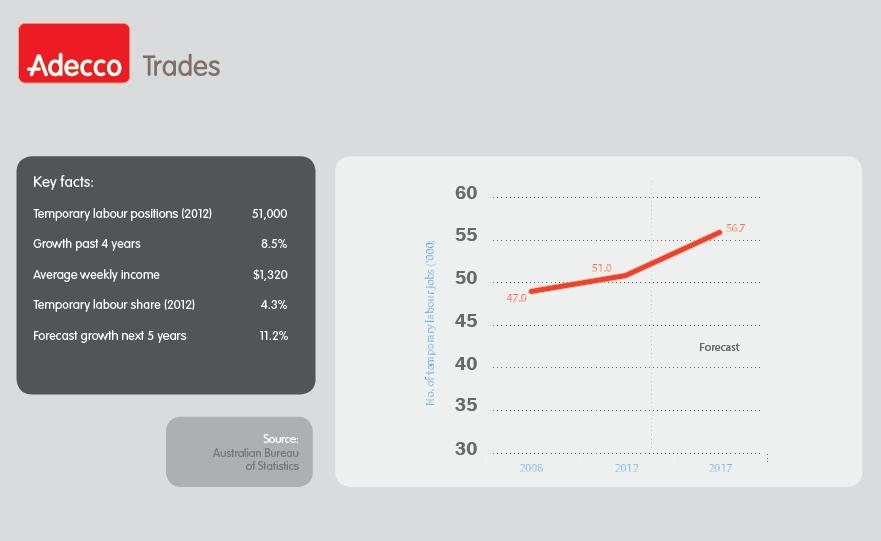Trade Jobs to grow

The use of temporary workers now accounts for 51,000 jobs or 4.3% of all trades roles in Australia.
With the temporary workforce expected to break 500,000 by 2015, the Australian & New Zealand (ANZ) chief executive of the world’s largest recruiting company is urging policy makers to overhaul Australia’s antiquated industrial relations framework to better meet the needs of a rapidly changing, increasingly diverse workplace.
ADVERTISEMENT
Speaking at the launch the Adecco Group’s 2013 edition of the Temporary Labour Report, Adecco’s ANZ chief executive Jeff Doyle pointed out, “We have a 2% growth in temporary labour in 2012, and with almost 30% of Australians now working in part-time roles, our 20th century industrial relations framework does not reflect this shift to a more flexible workforce.
“We are in a situation where we’ve got young kids struggling to find a job to the other extreme of older Australians wanting to work – but not 9 to 5, 5 days week – so we can’t ignore the need for a more flexible industrial relations framework anymore,” Jeff says.
“And interestingly the Adecco report found professional and management roles experienced the largest increases in temporary engagement in 2012 with a rise of over 30%, contradicting the assumption that temporary labour is primarily used in unskilled labour sectors,” he adds.
The use of temporary labour has grown across almost all industries in the last four years. In addition to the 8.5% growth in trades, mining and resources topped the list with 91.7%, followed by energy and utilities with 51.1%, engineering and technical (29.5%), sales and marketing (21%), government (13.7%), accounting and finance (9.2%), trades (8.5%), transport and logistics (7.5%), banking and financial services (5.6%), office support (5%) and manufacturing and operations with 0.6%growth. Contact centres were the only sector to experience a decline with a drop of 2.5%.
The 2013 Temporary Labour Report also found that over half of the organisations surveyed (53.6%) expect to hire temporary employees in 2013.
“Equally, the continued rise in temporary labour reflects the need for Australian companies to have flexibility to address the skills shortage that continues to be a significant issue, with our report identifying 86% of organisations surveyed expect to face a skills shortage in 2013,” Jeff says.
“Over the last few years, temporary labour is proving itself as the key factor in sustaining a competitive and robust marketplace in Australia. Giving companies the ability to manage resource fluctuations, expand easily and increase workforce participation across society, can often mean the difference between offering a temporary job and not offering a job at all in this environment of subdued business confidence.
“Temporary labour also helps to reduce the pool of under-utilised developed talent in this country by giving older professionals, carers and students the opportunity to participate in the workforce in a way that suits them.
“And the total youth unemployment rate for Australian’s aged 15 to 19 is 17%,” Jeff says.
“While many of these teenagers are still in education, a part-time or casual seasonal job will give them their first employment experience and may lead to their first role after school or college.
“It is essential that businesses can hire these teenagers easily so we can increase the employability of our youth by building their workplace skills and experience while addressing our very real skills shortage at the same time,” Jeff adds.
One third of temporary workers who contributed to the Report intend to stay in their roles for over 2 years and the most popular reasons for choosing temporary labour are as a stepping stone to full time employment (30.5%), hard to find a permanent role (24.3%) and because they like the flexibility (20.2%).
-
ADVERTISEMENT
-
ADVERTISEMENT

